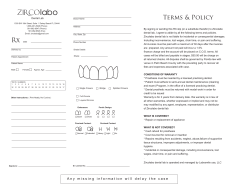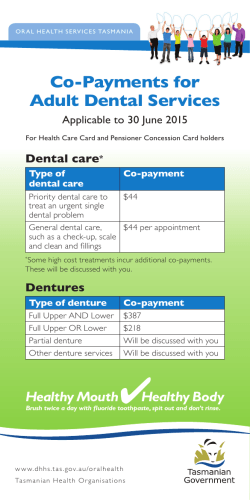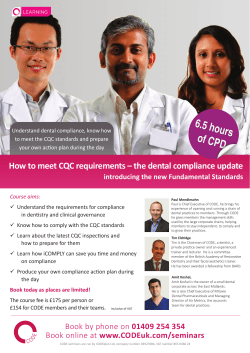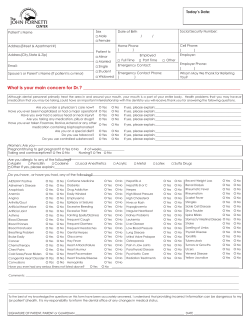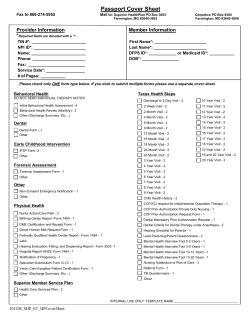
Knowledge, views and attitudes regarding the internet and
Scientific Journal of Dentistry (2014), 1, 3-7 ORIGINAL ARTICLE Knowledge, views and attitudes regarding the internet and its use in dentistry among dental undergraduate and postgraduate students: An observational study Rakhi Issrani1, Vaishali Keluskar2, Renuka Ammanagi3, Prabhleen Singh4, Namdeo Prabhu5 Department of Oral Medicine and Radiology, Saraswati Medical and Dental College, Lucknow, Uttar Pradesh, India, 2Department of Oral Medicine and Radiology, KLE Vishwanath Katti Institute of Dental Sciences, Belgaum, Karnataka, India, 3Department of Oral Medicine and Radiology, Maratha Mandal’s NGH Institute of Dental Sciences & Research Centre, Belgaum, Karnataka, India, 4Department of Oral Medicine and Radiology, KLE Vishwanath Katti Institute of Dental Sciences, Belgaum, Karnataka, India, 5Department of Oral & Maxillofacial Surgery, KLE Vishwanath Katti Institute of Dental Sciences, Belgaum, Karnataka, India 1 Keywords Dental, internet, questionnaire, students Correspondence Dr. Rakhi Issrani, Department of Oral Medicine and Radiology, Saraswati Medical and Dental College, 233, Tiwariganj, Faizabad Road, Lucknow - 227 105, Uttar Pradesh, India. Email: [email protected] Received 9 October 2014 ; Accepted 12 October 2014 doi: 10.15713/ins.sjod.2 How to cite the article: Issrani R, Prabhu N, Keluskar V, Ammanagi R, Singh P. Knowledge, views and attitudes regarding the internet and its use in dentistry among dental undergraduate and postgraduate students: An observational study. Sci J Dent 2014;1:3-7. Abstract The use of computer and information technology is on an escalation. The prime purpose of the present study was to know the extent of the internet use in dentistry. There is little contemporary literature outlining the knowledge, views and attitudes of dental students regarding the use of the internet in dentistry especially in our country-India. Hence, it was decided to conduct a pilot questionnaire study regarding the internet and its use in dentistry among dental undergraduate (UG) and postgraduate (PG) students. A prospective, cross-sectional, self-designed questionnaire with questions on various aspects of usage of the internet by the dental students was circulated among the UG and PG students at two dental institutes of Belgaum, Karnataka, India at KLE Vishwanath Katti Institute of Dental Sciences and Maratha Mandal’s NGH Institute of Dental Sciences and Research Centre. Completed questionnaires were received from 284 out of total 335 UG students and 112 out of total 196 PG students with a response rate of 84.8% and 57.14% respectively. 82.04% of UG and 87.5% of PG students had personal laptops with access to the internet, indicating easy accessibility to technology. E-mail/surfing was the most common purpose of the internet use among all the students. 77.8% of UG and 85.7% of PG students agreed that the internet use represent a threat to dentist-patient relationship. The results of this questionnaire survey can be basically taken as an eye opener which discusses various reasons for use of the internet by UG and PG students. Our study attempts to highlight that this technology is regularly used for entertainment than for academic purposes. Hence each graduating dentist should not only have a thorough knowledge of the internet, but should also be trained for literature search and this can only be accomplished by proper and compulsory training of these students for various applications of the internet in dentistry as practicing evidence-based health care might come in huge way tomorrow. Introduction The internet has taken the world by storm within the last few years. It has gradually become the most essential part of daily lives both in society and education. Today it is estimated that more than 30 million people all over the world use the internet for commerce, education, research, entertainment, recreation and even business opportunities.[1] In developing countries, the internet is still only available to a minority of health professionals, and often it is not available at the point of care. India is also a developing country.[2] At present, India has 60,000,000 internet users, which comprises 13% of Asia’s total internet use population (461,703,143 users, which is 37% of the world’s internet users) (Internet World Stats, 2007).[3] The development and expansion of the internet represents one of the greatest advances in our ability to communicate and disseminate knowledge.[4] The literature shows that the extraordinary growth of the internet is rapidly increasing and has become a valuable source for delivery of quality health Scientific Journal of Dentistry ● Vol. 1:1 ● Nov-Dec 20143 Issrani, et al. Internet and dental students sciences information for patient care and evidence-based care.[5] To a dentist, this means reliable dissemination of information; electronic patient communication and appointment scheduling; patient referrals to colleagues and transfer of their records to distant locations; online diagnostic analysis, backup, and retrieval; submitting manuscripts to journals; distant learning through webinars; or real-time interactions without the physical presence of faculty.[6] Students have the opportunity to learn about different views on controversial topics, review extensive case reports, and gain knowledge of rare diseases. In addition, to serve as a learning tool, the internet may motivate students to undertake research and help them develop skills in collecting and analyzing data. To the patient, the internet is useful in obtaining dental information, maps, and direction; checking accounts and making payments, and also for checking, making and changing appointments.[7] The opportunity for unlimited, rapid access to vast quantities of knowledge via internet is dependent upon us. However while access to the internet is exciting and unrestricted, information on the internet is generally unevaluated. There is equally great opportunity to be misleading and waste time. This prevailing, widespread network will have a significant impact on how dentists process and present information in the coming decades.[8] Although there has been considerable research into the impact of the internet on medical care in general, its impact on dentistry has been less intensively examined.[4] Against this backdrop, the present study was conducted to seek the views of a representative sample of the dental students of Belgaum, a part of North Karnataka in South India on following aspects of how the internet has impacted dentistry, namely to: 1. Estimate the extent and purpose of the internet usage among undergraduate (UG) and postgraduate (PG) students, 2.Identify factors that encourage the students to use the internet, 3. Determine the factors influencing the delivery of oral care to patients, 4. Estimate the extent of use of the internet by dental students themselves, and 5. Assess the topics of interest in dentistry of the students and patients regarding the internet. Methodology The research protocol for this study was reviewed and approved by the Institutional Review Board of two dental institutes of Belgaum, at KLE Vishwanath Katti Institute of Dental Sciences (KLE VKIDS) and Maratha Mandal’s NGH Institute of Dental Sciences and Research Centre (MMDC). Study design A prospective, cross-sectional, questionnaire-based study was conducted at KLE VKIDS and MMDC, Belgaum from July 2011 to September 2011. 4 Study population The sample frame consisted of 335 UG and 196 PG students. Study tools Following an extensive review of the literature, a questionnaire was designed in the Department of Oral Medicine and Radiology, KLE VKIDS, Belgaum by a study team, which consisted of 15 structured questions and a combination of open- and closedended questions, which were initially piloted to a small focus group to know the validity and clarity of questions who were not included in the study. The questionnaire consisted of following four categories: A. Demographic characteristics (Questions 1-2), B. Information about use of the internet (Questions 3-9), C. General opinion about the usage of the internet (Questions 10-12), and D. Information about the internet affecting dentist-patient relationship (Questions 13-15). Study procedure Participation in this study was voluntary, and all participants remained anonymous. Information on gender, age, and year of study was requested in the questionnaire. During the study period, two batches (2009-2010 and 2010-2011) of UG students (third and fourth year) were available. The questionnaires were distributed in appropriate lectures and retrieved immediately after completion. Among the PG students working in different dental disciplines in two institutions, three batches were available (2009-2010, 2010-2011 and 2011-2012). They were contacted during working hours in their respective departments. A verbal explanation of the rationale behind this study was given to students before they agreed to participate in the survey. The pilot testing indicated that completion time was approximately 6 to 7 min. The questionnaire was hand delivered to all the UG and PG students and was collected the next day. The participation was made entirely voluntary, and the purpose of the survey was briefed to them after obtaining the informed consent. It was assured at the beginning of the questionnaire itself that the results of the survey would be only presented or published as an aggregate data maintaining the confidentiality of personal information. Statistical analysis The returned questionnaires were checked for completeness of data and were recorded in a standard proforma. The data were then analyzed by means of the Statistical Package for the Social Sciences (SPSS PC VERSION 15.0, International Business Machines SPSS Statistics). Results and Observations The overall response rate of 84.8% (284 out of 335) was obtained from UG students whereas it was only 57.14% (112 out of 196) Scientific Journal of Dentistry ● Vol. 1:1 ● Nov-Dec 2014 Issrani, et al. Internet and dental students from PG students. The UG students were in the age range of 1824 years, and PG students were in the age range of 25-30 years. Among UG students, the female population (58.45%) was more as compared to the males (41.55%). Among PG students, there was almost equal representation of sex i.e. 45.53% of the participants were females [Table 1]. The present study showed that among UG and PG students, 82.04% and 87.5% respectively had personal computers/laptops and among all the participants, the internet was accessed most commonly from home. 47.89% of UG and 53.57% of PG students accessed the internet through mobile phones. Most of the participants (50.7% and 70.54% of UG and PG students, respectively) have been using the computers for more than 8 years and 56% of UG students had been accessing the internet for 1 to 3 h/day whereas 64.29% of PG students had been accessing the internet for 4 to 6 h/ day with Google being the most common search engines used by all the participants. Most of the UG and all the PG students were aware of online dental courses, journals, publications, etc. [Table 2]. When asked about the reliability of the information on oral health available on the internet, 94.37% of UGs and 73.21% of PG students agreed that the information on oral health available on the internet is reliable. All the participants had common view about the various reasons (recent trends, time saving, easy accessibility, etc.) for preferring the internet as a source of dental information with e-mail/surfing being the principle purpose of the internet usage [Table 3]. When asked about the patient dissatisfaction due to dependency upon the internet information, 55.63% of UG and 72.32% of PG students agreed to the fact the usage of the internet by the patients had led to their dissatisfaction due to increased demand of inappropriate interventions. 77.81% of UG and 85.71% of PG students believed that the internet represent a threat to dentist-patient relationship [Table 4]. Table 1: Questionnaire items on demographic profile of students UG student (n=284) PG students (n=112) Question 3 Have personal laptops/computers UG student PG students (n=284) (n=112) Yes No Yes No 233 51 98 14 Question 4 Primary place of internet access Home/hostel 192 51 College/work place 58 38 Cyber cafe 34 23 Question 5 Browse internet through mobile phones Question 7 Time of access of the internet per day (in hours) Yes No Yes No 136 148 60 52 1‑5 5‑8 >8 1‑5 5‑8 >8 88 52 144 10 23 79 1‑3 4‑6 >6 1‑3 4‑6 >6 159 41 84 17 72 23 Question 8 Common search engines used Google 195 86 Yahoo 89 26 Others 14 21 Question 9 Yes No Yes No Awareness about Question 1 21.46±3.2 28.6±4.1 Question 2 Gender (male:female) Questionnaire Years of using the internet The internet is extensively used among the current generation of dental students. The present study highlights certain points, some of which are congruent while few vary from earlier studies. In the present study, an overall response rate of 84.8% (284 out of 335) was obtained from UG students whereas it was 57.14% (112 out of 196) from PG students. A study conducted on UG students in Chile found an overall response rate of 81% Age (in years) (mean±SD) Table 2: Questionnaire items on information about use of the internet Question 6 Discussion Questionnaire (268 out of 332).[9] The UG students were in the age range of 18-24 years (mean ± standard deviation [SD] = 21.46 ± 3.2) and PG students were in the age range of 25‑30 years (mean ± SD = 28.6 ± 4.1) in the present study. This is consistent with the findings of previous study conducted in India where the majority of the respondents were in the age range of 15‑25 years.[2] Gender-wise comparison revealed that among UG students, the female population (58.45%) was more as compared with the males (41.55%). Among PG students, there was almost equal representation of sex i.e., 45.53% of the participants was females. We can definitely appreciate the increasing number of females in the sector of higher education. Similar findings were noted in studies conducted in Yazd and Chile.[7,9] But a study conducted in Jordan reported that female UG dental students use the internet less frequently than male students.[10] The present study showed that among UG and PG students, 82.04% and 87.5% respectively had personal computers/laptops, a finding similar to a study conducted in India revealed that majority of the dental teachers and students 118:166 SD: Standard deviation, UG: Undergraduate, PG: Postgraduate 61:51 219 65 112 ‑ Online dental journals and publications 200 Online dental courses 84 112 ‑ Online library resources 82 112 ‑ 202 UG: Undergraduate, PG: Postgraduate Scientific Journal of Dentistry ● Vol. 1:1 ● Nov-Dec 20145 Issrani, et al. Internet and dental students Table 3: Questionnaire items on general opinion about the usage of the internet Questionnaire UG students (n=284) Yes No PG students (n=112) Yes No 268 82 Question 10 Views about reliability of information on oral health available on the internet 16 30 Question 11 Reasons for preferring the Internet as a source of dental information Recent trends, latest advances 284 112 Time saving 284 112 Easy accessibility 284 112 Cheaper than printed ones 251 112 Education (accessing journals, treatment guidelines, e‑book, statistical software) 181 112 Send or receive email 284 112 Chatting 284 96 Entertainment (download movies, music, wallpapers, screensavers) 179 99 Others (news/buy products/ banking/rail and airway reservation) 122 58 Question 12 Principle purpose of internet use Table 4: Questionnaire items on information about the Internet affecting dentist‑patient relationship Questionnaire UG students (n=284) Yes No PG students (n=112) Yes No 158 126 81 31 221 63 96 16 221 63 96 16 Question 13 Do you perceive that Internet information has led to increased patient dissatisfaction? Question 14 Does the Internet foster demand for inappropriate interventions? Question 15 Does the Internet represent a threat to dentist‑patient relationship? UG: Undergraduate, PG: Postgraduate (73.7%) under study have their own personal computers or laptops.[2] The present study showed that among all the students, the internet was accessed most commonly from home and only a small percent of students used computers at college. This indicates availability and accessibility are increasing 6 less of a barrier to course delivery outside the educational institute.[8] This finding is consistent with data found in an earlier study conducted in Jordan[10] and Europe[11] where 72% of the students had access to computers at home. But this figure was lower than the 100% UG students at college of Chile[9] followed by 70.8% of UG students in India[2] where the internet was accessed most commonly from college. In our study, majority of the participants have more than 8 years of experience of the internet use. This proportion was >21.6% for Jordan students.[10] 56% of UG students had been accessing the internet for 1-3 h/day, whereas 64.29% of PG students had been accessing the internet for 4-6 h/day. This is higher than the 5% for Bristol, 20% for Manchester, and 22% for Newcastle students cited in a study conducted in the UK.[12] Google was the most common search engines used by all the participants, a finding inconsistent in a study conducted in Jordan where yahoo was the most commonly used search engine.[10] When asked about the reliability of the information on oral health available on the internet, majority of the students agreed that the information on oral health available on the internet is reliable. This is in agreement with the results found in a study where the majority of the students reported that the information on the internet was “fairly” or “moderately” relevant to dentistry and accurate. This may reflect an ongoing improvement in the quality of websites providing dental informatics.[10] Time saving was the main reason for preferring the internet as a primary source of information among UG students and updating with recent advances was the reason for PG students unlike the study conducted in India among medical students.[13] The principle purpose of the internet use in the present study for majority of the participants was e-mail/surfing or chatting, which was in strong contradiction with 91% of students using computers for academics at college of Jordan.[10] When asked about the patient dissatisfaction due to dependency upon the internet information, 55.63% of UG and 72.32% of PG students agreed to the fact the usage of the internet by the patients had led to their dissatisfaction due to increased demand of inappropriate interventions. The evolution of the internet has enabled the public to view vast reserves of information at the single click of a computer mouse, to the extent that access to dental information is no longer the sole reserve for dental professionals. As a result, the internet has potential to educate and empower the dental consumer by providing information on oral health services and by supporting self-help and patient choice.[14] A study conducted in Wales to identify how patient information on the internet has influenced the delivery of oral care and the use practitioners make of the internet concluded that 39% of respondents agreed that information gained from the internet had led to patients demanding inappropriate care and unrealistic expectations in treatment outcomes, particularly with regard to cosmetic and orthognathic procedures.[4] 77.8% of UG and 85.7% of PG students believed that the internet represent a threat to dentist-patient relationship as the can lead to disagreements on a course of treatment resulting Scientific Journal of Dentistry ● Vol. 1:1 ● Nov-Dec 2014 Issrani, et al. in tension between the dental practitioner and the patient, similar to the findings reviewed previously by few authors.[15] Even though we think technology is exciting, it is critical that our personal interactions exceed the influence of technical gadgetry. It might be the technology that wows the patient at first, but it is the personal relationship that the patient will remember, so we must not allow technology to get in the way of developing relationships.[16] The overall impression of the present study was that UG and PG dental students who participated in the study seemed to be computer literate but they used the internet more frequently for personal work than academic purposes. Conclusion Technology is reinventing the world, and dentists need to keep pace with the people they serve. These new and not-so-new technologies will enhance dental services and productivity, which ultimately will raise the bar for the standard of care in dentistry. The internet is a marvelous communication tool that definitely has a place in dentistry, however, the same degree of caution and similar criteria should be applied to evaluating information and data from internet sources. In this situation the academic dental community needs to be more vigilant to ensure that electronic dental information are authentic. They should aid students to get trusted dental information from the internet. The data obtained from the present study indicates that majority of the dental students who participated in the present study embrace and use of the internet to access dental information. Hence, we believe that the value of available internet resources and of electronic communication in supporting dental learning can no longer be denied. Studies of the internet knowledge and use among dental students are important tools to assess the need to train them in the use of this technology. Although the results of this study reflect the attitudes of dental students to internet use as a part of their education, multicenter studies would give a more reliable picture about the use of the internet by dental students in India. The issues raised here may not be generalizable to all dental schools in India, but we believe that a significant number of those schools face these challenges. The study could have recruited more students from different dental colleges which can enhance the validity of the study hence present results should be viewed as preliminary. Internet and dental students Acknowledgments The authors are thankful to all the participants for their kind support. References 1. Tan J, Leung D, Tay P. The use of the Internet in dentistry. Br Dent J 1997;182:191-4. 2. Manhas R. Use of the internet and electronic resources for dental science information: A case study. Lib Philos Pract 2008:1-8. Available from: http://www.unllib:unl.edu/lp. [Last retrieved on 2010 Feb 10]. 3. “Internet World Stats: Usage and Population Statistics.” Available from: http://www.internetworldstats.com/top20.htm. [Last retreived on 2010 Mar 22]. 4. Chestnutt IG, Reynolds K. Perceptions of how the Internet has impacted on dentistry. Br Dent J 2006;200:161-5. 5. Rosenberg M, Reed KL. Internet resources for dental anesthesia. Anesth Prog 1999;46:30-6. 6. Revankar AV, Gandedkar NH. Effective communication in the cyberage. Am J Orthod Dentofacial Orthop 2010;137:712-4. 7. Ayatollahi J, Ayatollahi F, Bahrololoomi R. Using the internet among dental students in Yazd. Dent Res J (Isfahan) 2010;7:7-11. 8. Simonsen RJ. Dentistry and the Internet – Enthusiasm mixed with caution. Quintessence Int 1995;26:663. 9. Uribe S, Mariño RJ. Internet and information technology use by dental students in Chile. Eur J Dent Educ 2006;10:162-8. 10.Rajab LD, Baqain ZH. Use of information and communication technology among dental students at the University of Jordan. J Dent Educ 2005;69:387-98. 11.Walmsley AD, White DA, Eynon R, Somerfield L. The use of the Internet within a dental school. Eur J Dent Educ 2003;7:27-33. 12.Grigg P, Macfarlane TV, Shearer AC, Jepson NJ, Stephens CD. Computing facilities available to final-year students at 3 UK dental schools in 1997/8: Their use, and students’ attitudes to information technology. Eur J Dent Educ 2001;5:101-8. 13.Banerjee I, Biswas S, Biswas A, De M, Begum SA, Haldar S. Trends to access internet among medical students of a government medical college in West Bengal. J Indian Med Assoc 2011;109:459-61. 14.Ní Ríordáin R, McCreary C. Dental patients’ use of the Internet. Br Dent J 2009;207:583-6; 575. 15.Anderson JG, Rainey MR, Eysenbach G. The impact of cyber health care on the physician-patient relationship. J Med Syst 2003;27:67-84. 16.Paquette DE. Use of technology in the orthodontic practice: A day in the life. Am J Orthod Dentofacial Orthop 2009;136:607-10. Scientific Journal of Dentistry ● Vol. 1:1 ● Nov-Dec 20147
© Copyright 2025

